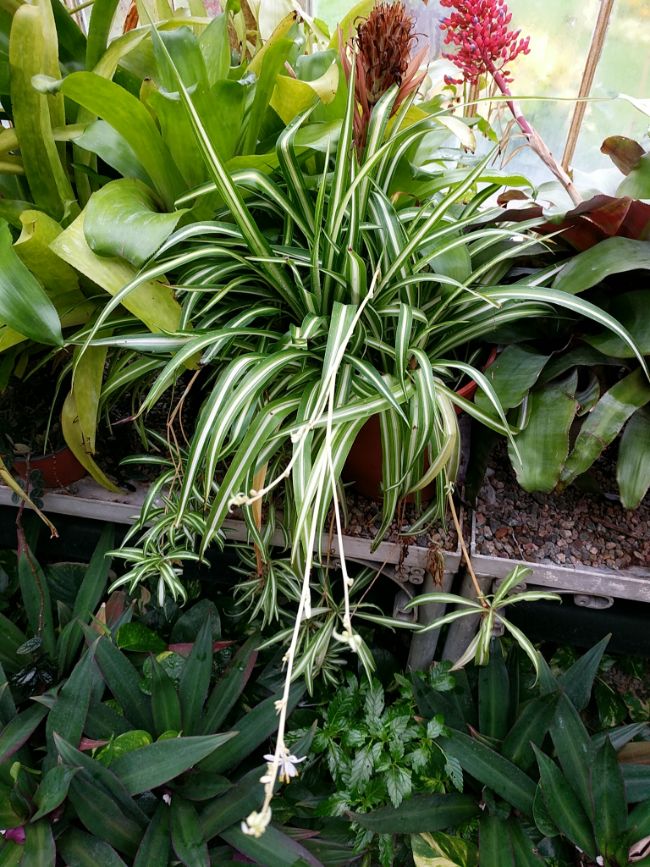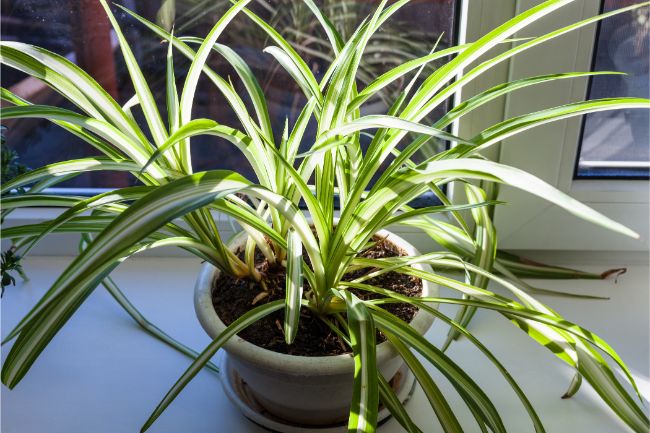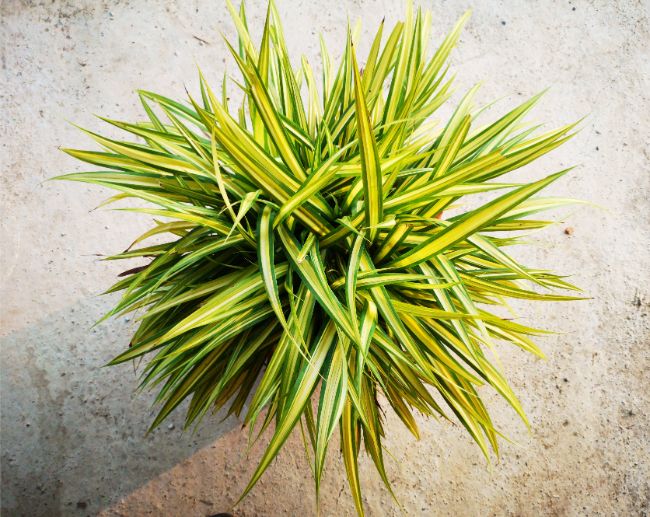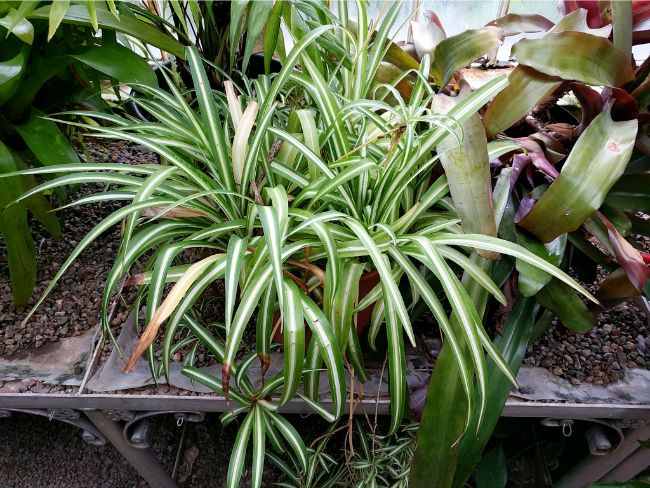They’re supposed to be easy to care for, so why is your spider plant dying? Your black thumb isn’t to blame; other factors are impacting the health of your spider plant. In this article, I’ll explain why spider plants don’t always thrive and what you can do about it.
Why is my spider plant dying? Most spider plants suffer when they get too much or too little water, an overload of fertilizer or an insect infestation. You can diagnose the problem based on specific symptoms. For example, black tips on the leaves are usually a sign of a moisture issue.
Spider plant leaves can become discolored for other reasons, though. Read on to diagnose your plant’s issue and learn how to revive it.
Why Is My Spider Plant Dying?
If you think that your spider plant is dying, inspect it to determine the cause. Once you know what’s wrong with it, you can take the proper measures to bring it back to its natural splendor.
What Color Are The Leaves?
Are the tips of the leaves a different color than the rest of the plant? Black or dark brown leaves could indicate that you’re watering it too much. Don’t let the soil become soggy. The surface of the soil should be dry touch before you water it again.
Are the leaves turning yellow? This could be a sign that you’re fertilizing the spider plant too frequently. Yellow leaves can also indicate that the plant is not getting enough light.
If your plant develops rusty, tan or gray tips, it might be reacting to the minerals in water. You could also have a problem with fertilizer buildup.
Is The Plant Drooping?
A wilted spider plant is not getting enough nutrients. This could mean that the soil quality is poor, the exposure to sunlight is inadequate or the plant is outgrowing its pot.
If you’ve been fertilizing it according to the schedule that I describe below, then the problem is probably the lighting. A plant that has been kept in a shady spot might do better in an area that gets more indirect sunlight during the day. Try placing the plant in a cooler, darker space if it’s drooping while exposed to bright light.
Is The Spider Plant Multiplying?
As the days get longer in the spring, spider plants often produce flowers. Those flowers turn into tiny plantlets after they fade. The tiny replicas of the main plant can be propagated, which I describe in more detail later in this article.
You might worry that your plant is dying if it doesn’t produce plantlets. It’s probably not dying. You can still encourage it to produce flowers and offshoots.
If its pot is too large, a spider plant will produce more foliage than flowers. Try moving it to a smaller pot.
You can also stimulate plantlet growth by keeping the spider plant in a room that gets dark at night during the fall. In the spring, allow it to get abundant light.
Sometimes, the plant doesn’t make babies if it gets too much fertilizer. Try cutting down on the feeding schedule.

Do The Leaves Have Spots, Holes Or Residue?
Although spider plants are highly resistant to insect infestations, they can be damaged by pests. Whiteflies create an ashy, black mold on the leaves of the plant. If you disturb a leaf that has whiteflies, it might look like a dusty cloud sprung up around it.
Spider mites make the leaves turn yellow and curl up. Aphids congregate in tiny clusters. Both of these insects can make the leaves sticky to the touch. Check the underside of the leaves for this substance if your plant looks a bit unhealthy.
If you’ve found bugs on your spider plant, but don’t know the best way to get rid of them, read my guide on how to get rid of houseplant bugs naturally.
How To Revive A Dying Spider Plant
Before you assume that you need to nurse your spider plant back to health, consider that you may be doing too much already. Spider plants flourish when they’re treated with a little neglect.
What To Do If You Have Water Problems
Most experts suggest adjusting your watering schedule if your spider plant isn’t doing well. If you’re watering your plant too much, slow down. Spider plants aren’t that thirsty.
A general rule of thumb is to water a spider plant when the top inch of soil is dry. Push your finger into the soil to check the moisture level.
The first year that you have a spider plant, you should water it about once a week. After that, you can water it even less. Never let your plant sit in a saucer of water. Also, make sure that the container and potting soil provide adequate drainage.
Read these awesome tips to help you know exactly when to water your indoor plants.
What To Do About Fertilizer Issues
Spider plants are sensitive to minerals. If you’re watering the plant properly and it has discolored leaves, try switching to distilled water. This will prevent the plant from taking up minerals, such as fluoride, that are present in tap water.
In the spring and summer, use a water-soluble fertilizer every two weeks or so. Fertilize the plant every month in the fall and once during the winter. You might need to fertilize your plant even more frequently if it is developing plantlets. You probably shouldn’t fertilize the plant if it’s outgrowing its pot.
This is the fertilizer that I use for my spider plants. My spider plants love it, but make sure to prepare it at half the recommended strength to avoid issues with excess fertilizer. I’ve also written an article about some great natural fertilizer options for your houseplants.
Consider repotting the plant every year with fresh soil. This removes fertilizer buildup that could be causing problems.
Adjust The Lighting
Have you moved your spider plant recently? It may just be adjusting to its new environment. It should return to its normal color and texture soon.
Make sure that it’s not in direct sunlight to avoid scorching the leaves. Spider plants do need some natural light to produce the chlorophyll that makes them green, though. They love humid areas that receive indirect sunlight, such as in a bathroom with a window.
Your plant shouldn’t get too hot, though. Try moving it if it isn’t doing well next to a heater, furnace or stove.

Pruning A Spider Plant
One of the easiest ways to keep your spider plant healthy is to trim discolored leaves. Use sharp, clean scissors or pruners. Snip off any areas that look unhealthy, mimicking the point at the plant’s tip by cutting at an angle. Trim back plantlets by cutting the long stem as close to the base of the mother plant as possible.
Dealing With Pests
Most experts suggest treating a spider plant with as few chemicals as possible. If your plant has bugs, try swabbing them gently with rubbing alcohol. This is especially useful for treating pests that produce a sticky residue.
You can also apply insecticidal soap or neem oil to the plant. Follow the directions on the package. Changing out the soil may improve pest infestations as well.
Read more about the best natural options to get rid of houseplant bugs.
Will Repotting Or Propagating Save Your Spider Plant?
Are you already watering your plant appropriately? Maybe it needs to be repotted. A root-bound spider plant won’t absorb water effectively. Therefore, repotting a spider plant can help it take up the moisture that you give it.
Spider plants have large, tuberous roots, which help the plant survive in periods of drought or when you’re on vacation and forget to hire someone to water your plant. If left unchecked, the roots can break a ceramic or terracotta pot because they grow so quickly.
Move spider plants to a larger container if the roots are visible through the soil’s surface or the pot’s drainage holes. When they’re in an adequately sized container, spider plants will use moisture efficiently.
Spider plants may produce small offshoots during the growing season. These plantlets draw nutrients away from the primary plant. You can trim and discard them. Alternatively, you can propagate these plant babies.
The bottoms of the plantlets root easily. Dangle them over soil-filled pots, and clip them from the main plant when the smaller ones develop roots. You can also snip off the smaller plants and root them in a glass of water before planting them in well-draining potting soil.
Can Spider Plants Live Outdoors?
You might be tempted to put your spider plant outside to revive it if it seems like it’s dying. However, it’s probably not a good idea to shock your plant by moving it from inside to an outdoor garden if it’s suffering. Try following the suggestions above to boost its health and resilience.
Spider plants can do well as perennials in gardens in zones 9 to 11. They also grow as annuals in cooler zones. They require soil that drains well and a shady spot that gets indirect light. Avoid too much sunlight, which can scorch the leaves.
These plants grow aggressively in warm climates. The plantlets will take root wherever they touch the soil.
Some people put their plants outside in the summer and bring them indoors before the first frost. If you would like to do this, wait until your plant is healthy before subjecting it to a dramatic change in climate.
Putting it outside makes it particularly susceptible to pests. If you’ve tried everything and your spider plant is not growing well indoors, though, it wouldn’t hurt to see what would happen if you put the pot outside.

Does My Spider Plant Have A Disease?
It’s rare for spider plants to develop diseases. The most common are fungal leaf rot or root rot, which are caused by overwatering and lack of airflow.
Are Fungus Gnats Harmful To Spider Plants?
Fungus gnats are attracted to the humid environment in and around potted plants. They can be a nuisance for humans but don’t usually harm the plant. Read about the different ways I recommend to get rid of fungus gnats.
Should I Mist A Spider Plant?
In arid conditions, misting your spider plant can improve humidity and help it stay healthy. Make sure that you use distilled water and continue to moisten the soil as usual.
I’m not a big fan of misting houseplants, as there are better ways to improve humidity levels for your plants. I’ve covered 10 of the best ways to improve humidity in this article.
Can Spider Plants Grow In Water?
You can root spider plant babies in glasses of water and keep them there for a few months. Eventually, they’ll need the nutrients that come from soil and fertilizer to flourish into a thriving plant.

